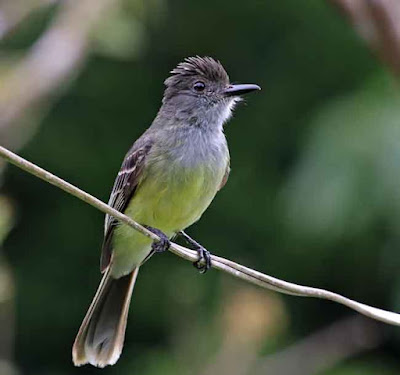I was planning to go to Peru in 2022 but there were riots and road closures in the areas we were planning to go. So at the last minute I went back to Colombia and saw some other places.
Unfortunately, there was a lot of overlap, so I did not get a lot of new birds on the trip. However, many areas now have set up feeding stations and several were built for photography. I used the same guide Pablo Florez and I had my daughter with me on the trip this year.
However on the bright side, the setups for photography and the number of places that had feeders allowed me to get many improved photos of birds I had not so good photos before.
The cracidae family consists of about equal numbers of chachalacas, guans and curassows. The former are usually easy to see and come to feeders, but the curassows are some of the most difficult birds to find. All are spectacular due to their size.
The 20" Colombian Chachalaca (Ortalis columbiana) is an endemic. It is the only chachalaca in its range in the central and western Andes. The white tips of the breast feathers gives a scalloped look.
 |
| Columbian Chachalaca |
Guans are similar but even larger. The 23" Andean Guan (Penelope montagnii) is much darker than the previous bird and the breast appears streaked rather than scalloped. I just love the genus name penelope - an old fashioned girls name.
 |
| Andean Guan |
The last is the 25" Sickle-winged Guan (Chamaepetes goudotii). It is plain brown with a rufous belly.
 |
| Sickle-winged Guan |
The next are single birds in each family that I photographed on the trip.
The 10" male Chestnut Wood-Quail (Odontophorus hyperythrus) was part of a covey of about 10 birds coming to a feeding station. These normally difficult to see birds are enchanting to see in the open and up close.
 |
| Chestnut Wood-Quail |
Next is the 19" Andean Motmot (Momotus aequatoralis). As you know motmots have racquet tails - with a bare shaft on the 2 long tail feathers before the racquet at the end of the tail. This is one of the 5 species that were split in the Blue-crowned Motmot complex. Here is the adult with the racquet tail. Another interesting habit is they swing their tails from side to side and not up and down like many birds.
 |
| Andean Motmot |
So are they born with the racquet tail? No, here is a juvenile and his tail is normal. The adults strip the bare area themselves when preening. This is another wonder of nature!
 |
| Andean Motmot - juvenile |
The only member of the trogon family for the trip was a 14" female Golden-headed Quetzal (Pharomachrus auriceps). She is the only quetzal in the Andes with a gray head and black undertail.
 |
| Golden-headed Quetzal - female |
The last 2 birds were both lifers and surprising to find. I had never even heard of the 11" Spot-flanked Gallinule (Porphyriops melanops). It is mostly confined to Peru to Argentina but there is a small population in the mountains east of Bogota. It was in a pond in the middle of a cattle pasture - so I walked out to get the photo. It looks like our Common Gallinule but it has a greenish bill and shield and of course the white spots on the flank.
 |
| Spot-flanked Gallinule |
The 13" Noble Snipe (Gallinago nobilis) was a special treat to see. It was in a boggy pasture and the farmer allowed us to go out to take the photos. The black line under the eye is diagnostic. Anytime I can find a snipe is always exciting. This is the usual way that you see them - hunkered down in the grass. There are 7 snipes in South America and this was my second one to photograph.
 |
| Noble Snipe |
But this one was wide open. The buffy spots on the tail are diagnostic for this species in the mountains.
 |
| Noble Snipe |
I put the different bird/mammal families in single folders for easy viewing
David McDonald
dkmmdpa@gmail.com
photos copyright 2006 - 2023 David McDonald
To have these trip reports sent to your email, please email me at the above address and ask to subscribe.









